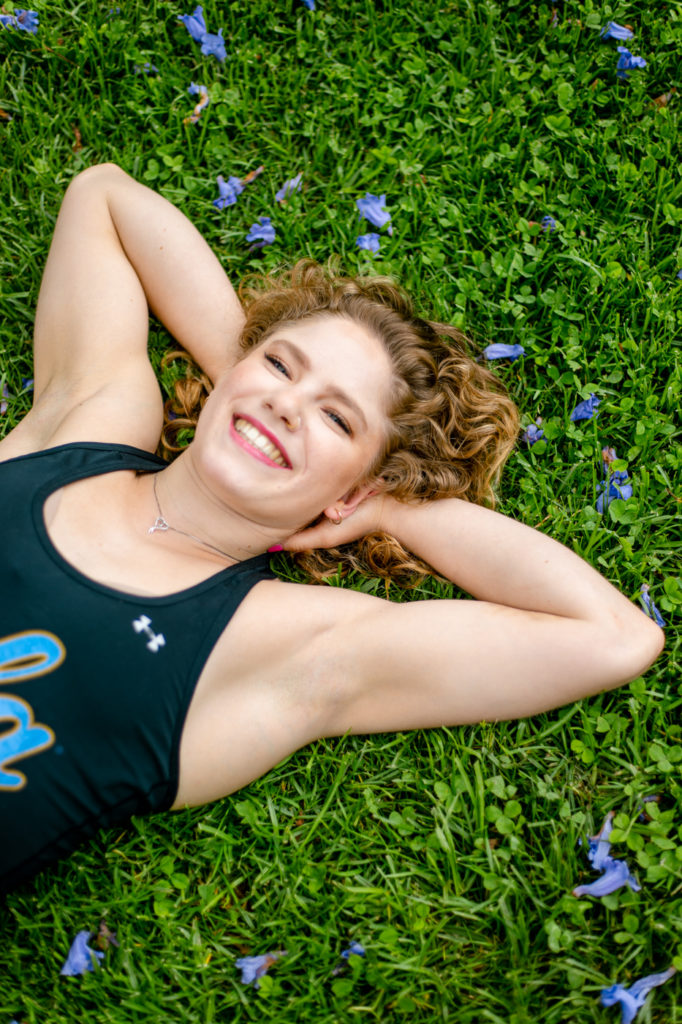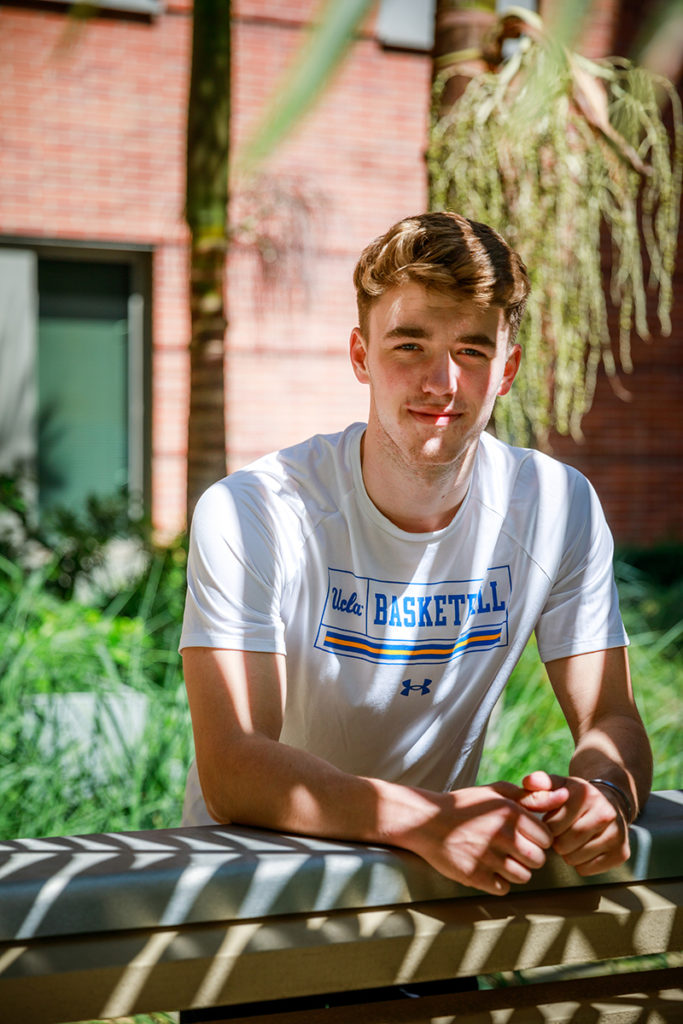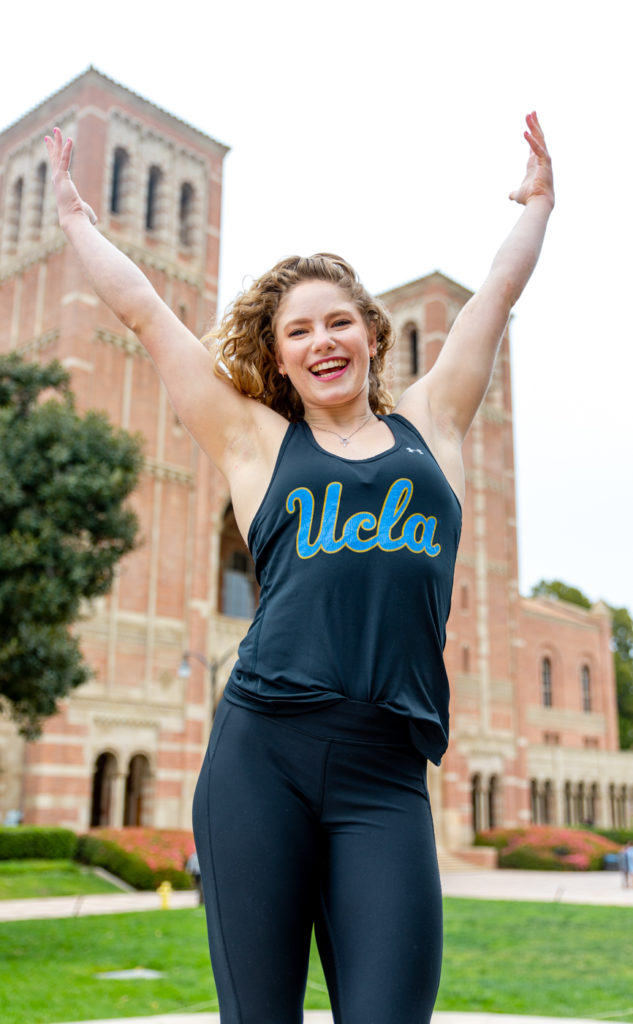(Tanmay Shankar/Daily Bruin senior staff)
By Abigail Siatkowski
June 6, 2021 at 5:13 p.m.
UCLA has been home to a number of nationally recognized athletes. From Olympic gymnast Kyla Ross to 2017 NBA MVP Russell Westbrook, many of the world’s top names in sports have once called themselves Bruins.
This story is not about them.
This story is for the sideliners and the third-stringers.
This one is for the walk-ons.
In the world of sports, walk-on athletes are defined as those who are not offered a scholarship to compete for a university. Some may be recruited and others may not be, but they all pay the same price to attend school as they would if they were not an athlete.
Different sports teams vary in the number of members who are walk-ons. According to Chris Waller, the coach of the gymnastics team at UCLA, only 12 of their athletes can be on scholarship at any given time.
Gymnastics qualifies as what is called a head count sport, Waller said, meaning that there is a maximum number of scholarships the team can give out. This is different from an equivalency sport, where there is an overall dollar amount the team is allowed to use for scholarships in any way they see fit. Because gymnastics can only give out 12 scholarships, the remaining seven athletes on the team are walk-ons.
Sara Taubman, a third-year human biology and society student, is one of them.
Taubman began her gymnastics career young, at the age of two or three. In third grade, she knew she wanted to pursue college gymnastics after watching a meet between UCLA and UC Berkeley. She loved how the women on the team celebrated each other’s routines, regardless of how well the performance went.
She went into the college recruitment process with realistic expectations, she said, aware that UCLA and other top-tier gymnastics schools might be a big reach.
But when a UCLA coach visited her high school gym to check on another athlete who had already committed to the Bruins, he spotted Taubman and asked if she had already signed on to another college’s gymnastics program. After sending video footage of her practices to the team’s coaches and visiting UCLA multiple times, Taubman was crying tears of joy – she had been offered a spot on the team.

Taubman is a recruited walk-on. All gymnasts in the program are recruited, Waller said. In other sports, this is not the case.
Russell Stong, a third-year mechanical engineering student, is a walk-on athlete on the men’s basketball team.
Like other nonathlete students, Stong was admitted to UCLA via the typical University of California application process. Only after his acceptance to the school did he officially get into contact with the basketball staff, even though they knew him to some degree from previous visits to his high school.
Once he initiated communication with them, he spent the summer before his freshman year in interviews and tryout practices, eventually earning a spot on the team.
As athletes, both Taubman and Stong start their days early.
Every morning, Taubman is up at 6 a.m. After she bikes to practice, she has treatment and workout preparation in the team’s training room. Then, it’s off to the gym for three hours of gymnastics, and then 30 minutes to an hour of weight training.
Stong also wakes up with the sun. Practice starts at 8 a.m. with stretching and rolling out, he said, and then the team lifts until 9 or 9:30 a.m. After about two hours of regular practice, they call it a day around noon.
Taubman’s schedule requires giving some things up, she said.
“There are times where you do have to sacrifice. You do have to say, ‘You know what, I can’t go to this party because I’ve got practice. As much as I want to, … I can’t,’” she said.
During his freshman year, Stong joined Bruin Racing, an engineering club where students build racing vehicles and compete them against other schools. But after a while, he found that basketball consumed too much of his time for him to be involved with the organization.

For as much time as they are putting into practice, neither Taubman nor Stong is seeing the same amount of action as some of their more well-known teammates. Despite being on the team since she was a freshman, Taubman’s competitive debut as a Bruin only happened this past year. And for Stong, his cumulative playing time this season was five minutes.
Shortly before the COVID-19 pandemic shut down universities nationwide, Taubman spoke to Waller about her future with the team. She said she wanted to take a step back and reevaluate the decisions she made about how to spend her time – not because she didn’t like gymnastics, but because all the other opportunities at UCLA were so enticing.
When she came to him, Waller discussed with her the pros and cons of leaving the team, he said. Though he doesn’t consider himself in a place to make judgments about the personal journeys of his athletes, he felt that if she chose to move on from the sport, the decision would be rooted in fear.
“I think the reasons for her moving on were a lot about a fear of not reaching her goals, or not getting enough out of (the gymnastics team), rather than embracing the journey,” he said.
But when the COVID-19 pandemic sent her and her teammates home, canceling their season, Taubman began to miss gymnastics and the presence of her teammates and the coaching staff.
Entering the gym again this fall, she had to relearn many important gymnastics skills. She felt like a little kid, she said, just enjoying the sport and challenging herself each day. She ultimately decided that, for her, continuing gymnastics was the right choice.
“I talked to (Waller) again and I was like, wow, I don’t know what I was thinking,” she said. “I want to do this, and I put my whole heart back into it and I really fell in love with gymnastics again this year.”
Even if she never got the chance to compete in a meet, Taubman would have no regrets about her choice to be on the team, she said.
“The prospect of having a dream come true is what makes life interesting,” she said, referencing a quote from Paulo Coelho’s “The Alchemist.”
Taubman’s dream came true this year at the team’s first meet of the season against Arizona State. When she learned that she had been placed in the lineup on the uneven bars, she felt excited. She dealt with some nerves in the warmup, but once it became time to suit up, she felt prepared.
“There was kind of this switch once we changed into our competition leotards, and I looked at myself in the mirror,” she said. “I stood there and I was like, ‘You know what, yeah, you deserve to be out there, you’ve put in this work and you’re ready.’”
During her routine, her teammates cheered her on from the sidelines. When she landed, they lost their minds, Waller said.
After her performance, the score took an abnormally long time to come out, probably around seven minutes, Waller recounted. As she waited, several of the other gymnasts came up to her, offering fist bumps and pep talks.
Finally, the score was announced – a 9.825. Taubman tied for fifth place on the apparatus. And later in the day, UCLA won the meet.
It was one of the best moments of his coaching career, Waller said.
“It wasn’t luck, it was preparation and opportunity coming together,” he added.
Stong’s teammates react similarly to Taubman’s whenever he steps out onto the court.
Wes Long, the assistant athletic performance coach for the men’s basketball team, said the team is elated whenever Stong is put in a game. Generally, Stong’s presence on the court means the team is playing well and the coaches feel confident in their ability to win, Long said. Getting to see a player like Stong, who works tirelessly every day in practice, finally taking his turn in a game is rewarding for the whole team.
“I know he enjoys it and he soaks it all in,” Long said.
Stong is passionate about basketball. He has fun with it, he said. Each day of practice brings him back to his childhood on the court. It would be difficult for Stong to walk away from the sport.
“I wouldn’t stop, even if I played zero minutes,” he said.
He appreciates the notable moments he’s gotten to experience with the team this year as part of their impressive March Madness run, like when they stormed the court after they beat Michigan to advance to the Final Four. Yet he doesn’t take for granted the little moments, either, such as playing video games or watching Formula One racing with his teammates. Even spending three weeks isolated in the “bubble” created for the March Madness tournament in Indianapolis was something to enjoy, he said.
Stong takes his role on the team seriously. It’s not all about playing time, Stong said. He can contribute to the team in other ways, like being the “bench spark plug” who brings the energy or simply listening to anyone who needs to talk.
Taubman also finds ways to be a part of the team, even when she’s not included in the competitive lineup.
“(Taubman) has more friends than any person on the team I’ve ever met,” Waller said.

She’s attentive and open-hearted, Waller said. These qualities are encouraging to new freshmen on the team, he added, who may be uncomfortable in their new environment. Before the COVID-19 pandemic, Taubman could hardly walk 20 feet without someone stopping her to say “hi,” Waller said.
When one of the gymnastics program’s former coaches, who was diagnosed with amyotrophic lateral sclerosis, came to speak to the team a couple months ago, Taubman began an individual conversation with him after he finished talking to the group, Waller said.
“After he spoke, of course (Taubman) would be the person to come up and want to have an extended conversation with him, because she just feels like, ‘There’s something I need to learn from this person,’” he said.
Long thinks the same of Stong.
Stong is a great example not just of a good walk-on athlete, but of a good athlete in general, Long said. Whoever eventually takes his place will have big shoes to fill, he added.
And as for Taubman – well, Waller says it best.
“She has an unwavering work ethic, she has a love of learning and she has a passion for the sport,” he said. “And all of those characteristics, they’re evident every single day.”
